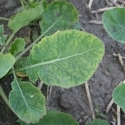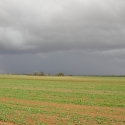21 May 2015
Molybdenum
It role in crops and pastures, Australia
 Mo deficiency in wheat
Mo deficiency in wheat
Molybdenum (Mo) is a trace element required in very small amounts for the growth of both plants and animals. Crop deficiencies of Mo are fairly uncommon, but when diagnosed, various soil and foliar fertilizers can be used to correct this condition. Deficiencies have been reported from acid, sandy soils and can be worse under minimum disturbance cropping systems.
Molybdenum in Plants
All plants require very small amounts of Mo for normal growth and development and Mo and nickel (Ni) are required in the lowest concentrations of all the essential nutrients. Within the plant, Mo is primarily used in the production of “molybdoenzymes” that regulate various plant functions. The most well known of these enzymes regulate nitrogen (N) nutrition. In non-legumes, Mo-enzymes regulate the conversion of nitrate into proteins (nitrate reductase). In legume crops, another Mo-enzyme (nitrogenase) is needed by the root nodule bacteria for N fixation. The Mo requirement of legumes is greater than that of grasses and other crops.
Molybdenum toxicity in plants is rare under most agricultural conditions. However, sheep and cattle feeding on plants with a high Mo concentration may suffer from molybdenosis. This condition is a result of high Mo concentrations suppressing the availability of dietary copper (Cu) in these animals. For this reason, regular applications of Mo are not recommended for pastures.
Legumes have a higher demand for Mo than cereals, and canola is similar to legumes. Vegetable brassicas have a relative high demand (see Table 2). The demand for Mo in canola is 5 to 6 times higher than for cereals.
Molybdenum in Soils
Plant-available Mo is in the anion form of MoO42-; or molybdate. It is released from solid minerals through normal weathering processes and then undergoes various reactions in the soil. Once it is dissolved, MoO42- anions are subject to adsorption processes on clays, metal oxides of iron (Fe), aluminum (Al), and manganese (Mn) as well as organic compounds, and carbonates.
The solubility of MoO42- is greatly influenced by soil pH, similar to the chemically analogous nutrient phosphate (PO43-). Molybdenum is the only micronutrient that has increased plant availability as the soil pH rises. Molybdate solubility increases approximately 100 times for every unit increase in soil pH.
Therefore, the use of lime to increase the pH of acid soils is an important management tool to improve Mo availability. Where soils have a pHCa of 5.0 or greater, it is uncommon to encounter Mo deficiencies.
Addition of sulfate (SO42-) fertilizer tends to decrease MoO42- uptake, as they both compete for root uptake sites. For example, one study showed that the plant Mo concentration of peanuts was decreased by more than 70% following fertilization with SO42- containing single superphosphate (SSP), but Mo concentrations increased by 20% following fertilization with triple superphosphate (TSP) fertilizer that contains no sulfate (Rabefka 1993). The addition of phosphate often results in the release of Mo that is adsorbed on soil solids, leading to greater Mo uptake and accumulation in plants.
Diagnosing a molybdenum deficiency
Because it is required in such small quantities, the diagnosis using soil or plant testing is analytically challenging and tests are more expensive than other soil or plant tests. Soil tests can be either CaCl2 or ammonium oxylate but neither test is reported as reliable in predicting Mo deficiencies over a wide range of soils (Brennan and Bruce, 1999).
Soil pH is an important determinant of the amount of available Mo, and risk of deficiencies increases where pHCa is less than about 4.5, and as soils acidify under agriculture, the amount of plant available Mo declines (Brennan and Bolland 2011). However, soil acidification can also increase the risk of potassium deficiency and aluminium toxicity, so the diagnosis can be difficult (Brennan et al. 2004).
Plant tissue tests can be used but, like soil tests, the reliability is relatively low. For example, Shovelton (1982) showed that sub-clover on Mo responsive sites generally had Mo concentrations of 0.1 to 0.2 mg/kg, but responses to added Mo were seen even when concentrations were 0.4 to 0.5 mg/kg. Despite this variability, critical youngest mature leaf Mo concentrations in mid-tillering wheat and pre-flowering canola have been reported as 0.05-0.09 mg/kg and less than 0.3-0.6 mg/kg respectively. Tissue tests are expensive as specialized equipment is required.
Molybdenum Deficiency Symptoms
Molybdenum is mobile within plants and deficiency symptoms can appear on the entire plant.
- · Non-legumes: Since adequate Mo is essential for proper N metabolism, deficiencies commonly appear as stunted plants and failure of leaves to develop a dark green color. In more severe deficiencies, the leaves may develop a pale green or yellow area around the edges and between the veins. Advanced symptoms of insufficient Mo may appear as burning (necrosis) around the leaf edges and between the veins, because the plant cannot assimilate the nitrate and convert it to protein. The most severely affected plants can show empty heads (like Cu deficiency or frost) and delayed maturity. A well-known Mo deficiency symptom has been described for cauliflower, which develops a “whiptail” when the leaf tissue fails to develop surrounding the mid-leaf vein.
· Legumes: These plants have an additional requirement for Mo, since it is required for N fixation by the root nodule bacteria, in addition to the internal utilization of nitrate. The symptoms of insufficient Mo include a general stunting and yellowing, typically seen as a result of insufficient N supply. Nodules are green and small.
Fertilizing with Molybdenum
In many soils, application of a liming material to increase pH will release Mo from insoluble forms. For example, a study showed that addition of lime alone resulted in the same soybean yield as when Mo fertilizer was added to unlimed soil. However, the chemical release of soluble Mo following lime application may take weeks or months to occur.
If lime is not required for crop growth or when the Mo concentration of the soil is low, it may be useful to fertilize with additional Mo in the following ways:
- · Soil: Molybdenum fertilizers can be banded or broadcast on the soil. It is commonly added in small amounts, ranging from 250 to 900 g/ha. It is often mixed with other fertilizer materials to help with uniform application or it may be dissolved in water and sprayed on the soil before planting. Molybdenum trioxide (MoO3) is only suitable for soil application due to its low solubility. The use of MnO3 at 150 g/ha has been shown to have a residual activity of up to 5 years (Kerridge & White 1977).
· Foliar: Soluble Mo sources, such as sodium or ammonium molybdate, are used for foliar application to plants. Foliar application of dilute solutions of Mo is generally most effective when applied at earlier stages of plant development. Foliar applications are beneficial for immediate correction of Mo deficiency symptoms, compared with soil applications, which have a longer residual benefit.
· Seed: Treatment of seed with small amounts of Mo fertilizer is common in regions where deficiency occurs. This technique ensures that each seed is uniformly provided a small, but adequate amount of Mo for healthy growth. Rhizobia inoculants for legume crops are sometimes amended with small amounts of Mo to promote vigorous N fixation. Excessively high application rates can lower seed germination or cause Mo accumulation to concentrations that may be harmful for grazing animals. Selecting seed from a crop with a good Mo history or from an alkaline soil can reduce the risk of deficiency (Brennan and Bolland 2007).
The selection of a specific Mo fertilizer depends largely on how the material will be applied. Some common fertilizer products containing Mo are given in Table 1.
Table 1. Some common fertilizer products containing molybdenum.
| Name | Chemical Formula | Mo Content | Solubility |
| Sodium molybdate | Na2MoO4.2H20 | 39% | 653 g/l |
| Ammonium molybdate | (NH4)2Mo7024.4H2O | 54% | 400 g/l |
| Molybdate trioxide | MoO3 | 66% | 3 g/l |
Crop Response to Molybdenum
The benefit of supplying adequate Mo most commonly relates to boosting the ability of plants to utilize N. Plant Mo deficiencies may not always require supplemental fertilization, especially in acid soils where application of lime will increase Mo availability to plants. Similarly, addition of P fertilizer releases Mo into solution after it exchanges with MoO4 2- on soil adsorption sites.
There is no evidence that high N supply can induce a Mo deficiency, or that crops – especially under high yielding situations become deficient in Mo as more N is supplied. In neutral to alkaline soils, there is adequate Mo to meet the demands of crops and pastures.
Table 2 shows some examples of Mo responses, all which come from situations where soil pH is very low, either from Western Australia or on the slopes in New South Wales. For example, Brennan and Bolland (2011) measured yield responses in canola to applied Mo in Western Australia on sites where pHCa <4.8. Where Mo is lacking, supplemental fertilization has resulted in large increases in plant growth and yield.
Table 2 Responses to supplementary molybdenum for a range of species.
| Crop | soil pHCa | Control | Plus Mo | Mo Rate | Reference |
| Canola | 4.6 | 1.75 t/ha | 1.99 t/ha | 40 g Mo/ha (mean of 3 sites) | Brennan & Bolland 2011 |
| Wheat | <4.4 | 1.25 t/ha | 1.60 t/ha | 70 g Mo/ha (mean 3 sites) | Brennan & Bolland 2007 |
| Subclover | 4.5 | 4.6 t DM/ha | 5.7 t DM/ha | 80 g Mo/ha | Brennan 2002 |
| Wheat | 4.4 | 1.63 t/ha | 2.42 t/ha | 120 g Mo/ha | Lipsett & Simpson 1973 |
| Wheat | 4.3 | 5.1 g/pot | 9.7 g/pot | 120 g Mo/ha | Lipsett 1975 |
| Phalaris | 4.3 | 10.0 g/pot | 3.7 g/pot |
References
Brennan RF. 2002 . Aust. J. Exp. Agric. 42, 565-570.
Brennan RF, Bolland MDA. 2007. J. Plant Nut. 30, 2005-2019.
Brennan RF, Bolland MDA. 2011. J. Plant Nut. 1186-1197.
Brennan RF, et al. 2004. Aust. J. Agric. Res. 44, 1031-1039.
Kerridge PC, White RE. 1977. Aust. J. Exp. Agric. An. Husb. 17, 669-673.
Lipsett J, Simpson JR. 1973. Aust. J. Exp. Agric. An. Husb. 13, 563-566.
Lipsett J. 1975. Aust. J. Exp. Agric. An. Husb. 15, 227-230.
Rebafka, F.P. et al. 1993. Fert Res. 34:233-242.
Shovelton, J. 1982. Department of Agriculture, Victoria
Additional Resources
Molybdenum NutrifactSize: 1.71 MB







